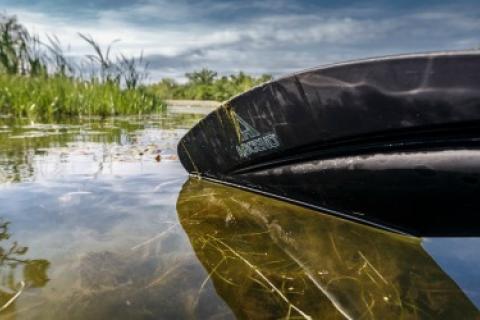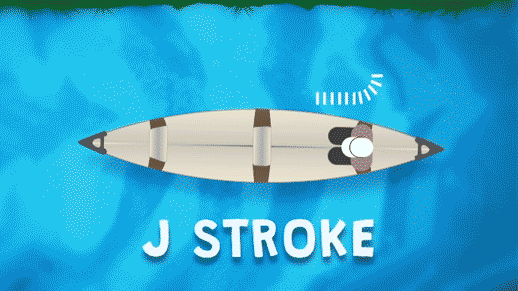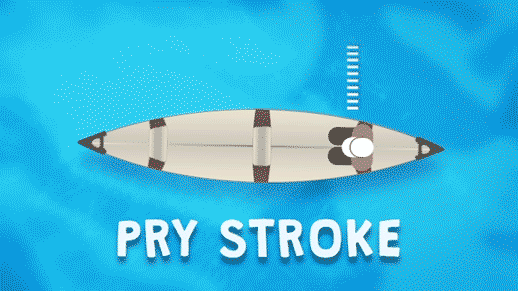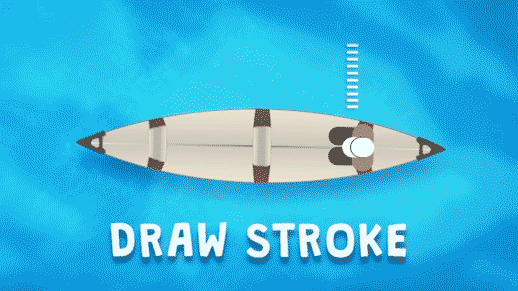
A day on the water should be fun. Learning a few basic paddle strokes will allow you to focus on the important things: friends, fishing, and enjoying your float. The following five strokes are easy to master and simple enough to remember on your next kayak or canoe outing.
1. How the Paddle Forward Stroke Works
 This is a common sense stroke and likely your first motion in a canoe. It is important to establish, however, as it is the foundation for almost all other strokes.
This is a common sense stroke and likely your first motion in a canoe. It is important to establish, however, as it is the foundation for almost all other strokes.
The paddle blade should remain perpendicular to you throughout the entire forward stroke. Insert the paddle into the water ahead of your knees, then draw it straight back. Remove the paddle from the water and repeat.
When the forward stroke is used, the canoe has a natural tendency to go in the opposite direction of the rear paddler’s stroke. This often results in the left, right, left, right cadence
2. How the Paddle Reverse Stroke Works
 The reverse stroke is adequately named, as it is essentially the forward stroke performed in reverse. It is helpful for slowing or stopping the canoe, and can also be used to go backwards in still water.
The reverse stroke is adequately named, as it is essentially the forward stroke performed in reverse. It is helpful for slowing or stopping the canoe, and can also be used to go backwards in still water.
Keeping the paddle blade perpendicular to your body, dip it into the water behind your hips and push it forward. Remove the paddle from the water and repeat as necessary.
Keep in mind that this will have the opposite effect of steering with the forward stroke, causing the front of the canoe to steer to the same side as the stern man’s stroke.
3. How the Paddle J-Stroke Works
 The J-stroke gets its name from the fact that it resembles the letter J when preformed on the left, or port, side of the craft. This stroke is especially helpful as it counteracts the tendency of the canoe to steer in the opposite direction of the stern man’s forward stroke. This allows you to move straight forward without switching sides—thus avoiding the “death march” cadence.
The J-stroke gets its name from the fact that it resembles the letter J when preformed on the left, or port, side of the craft. This stroke is especially helpful as it counteracts the tendency of the canoe to steer in the opposite direction of the stern man’s forward stroke. This allows you to move straight forward without switching sides—thus avoiding the “death march” cadence.
The J-stroke begins with a forward stroke, but when the paddle is even with your hips begin pushing it away from the canoe. Rotate the face of your paddle to follow the stroke. A loose grip, especially with your top hand, is required as the back of your hand should continue facing away from the canoe. This small detail will keep you much more comfortable during a long day of paddling.
4. The Paddle Pry Stroke
 The pry stroke is a simple way to force the canoe in the opposite direction of the paddle. It is most useful when pushing away from shore or squeezing into a tight space on a dock.
The pry stroke is a simple way to force the canoe in the opposite direction of the paddle. It is most useful when pushing away from shore or squeezing into a tight space on a dock.
To perform the pry stroke, insert your paddle into the water with the blade parallel to the canoe. Brace the shaft of your paddle against the craft, and push the blade away from you.
5. The Paddle Draw Stroke
This stroke is exactly opposite of the pry stroke. It allows you to move the canoe in the direction of the paddle. Mastering both the pry and draw will allow you to move your boat in the desired direction, even if you managed to float your way into a tight spot.
To execute the draw, insert your paddle in the same way as the pry stroke. Rather than bracing it against the gunwale, however, reach out into the water and pull the blade towards your hip.
Practicing these simple strokes on your next float will allow you to focus more on the fun and less on catching your belongings before they drift down the river. Be sure to share them with your canoe partner before you hit the water!
Tip: Basic How-to Guide to kayaking for Beginners (video)
- 10352 views

